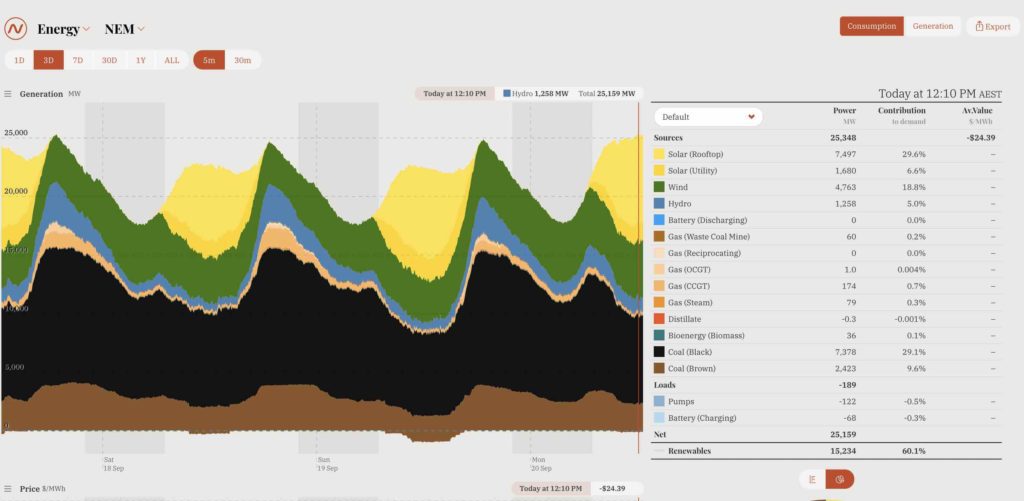Records continued to tumble on Australia’s main electricity grid on Monday, with the share of renewable energy smashing through 60 per cent for the first time, just a day after it had set a new record of 59.8 per cent.
According to Dylan McConnell, from the Climate and Energy College in Melbourne, and using data from OpenNEM, the share of wind, solar and hydro reached 60.1 per cent at 12.10pm on Monday, exactly one day and 15 minutes after it set the previous peak on a sleepy Sunday.
The fact that this new peak occurred on a working day rather than a weekend is also significant, and highlights the increasing pace of the green energy transition in Australia, as more wind and solar – and rooftop installations – are rolled out across the country.
Spring has been dubbed the season of records by the Australian Energy Market Operator and new benchmarks have been set for the growing share of renewables, the shrinking output of coal, and new lows for “minimum operating” demand over the last few weeks.

Sunday, according to another data watcher, Geoff Eldridge from NEMLog, witnessed not just the record for the share of renewable energy, but also the record for instantaneous wind and solar (57 per cent).
Other records broken on Sunday included:
NSW record maximum rooftop solar PV (2,694.4 MW) and corresponding lowest minimums for network demand (4,867.4 MW) and Operation Demand (5,065.0 MW).
The Australian Energy Market Operator also noted this record low of demand in NSW in a tweet, although they put it at 4,872MW, as predicted in a previous tweet.
“Spring is the season for records to bloom!” it said on Friday. “Forecast mild temperatures and sunny weather in NSW and QLD on Sunday may see rooftop solar drive down energy demand from the grid to a new record low!”
The fact that this occurred in NSW, the state grid with the highest dependency on coal generation is significant, and aligns the state government’s push to replace the ageing coal fleet of more than 10GW with wind, solar and storage under its renewable infrastructure plan.
According to NEMLog’s Eldridge, coal output on the main grid was at a record minimum of 9,161.6MW at noon on Sunday, (or at least the lowest since Nov 1, 2010), and was down 153.57MW on the previous minimum on Sunday, August 22 this year.
It was also a record low share of generation on the main grid for coal (38.97 per cent) and for combined coal and gas (40.05 per cent).
Other records noted by Eldridge included the maximum output for wind in Victoria (2644MW at 7pm on Sunday), the highest two-day rolling average for renewables in Victoria (47 per cent), and the highest rolling 12-month average in the NEM (29.18 per cent), in NSW (20.69 per cent), and Victoria (31.8 per cent).
On Monday, when overall demand was more than 2GW higher due to the increased industrial activity, the big mover in the main grid was wind energy, which was contributing 4,763MW, or 18.8 per cent of total demand, at the time the new renewable share record was set, although it reached a higher output and higher renewable share later.
Rooftop solar and utility-scale solar combined to deliver 36.2 per cent at the time of the new renewable share record on Monday, down from the 41 per cent they were contributing when the previous record was set on Sunday.
As usual, the share of wind and solar could have been significantly higher were it not for the level of curtailment, either economic (switching off to avoid negative prices), or network (being forced to switch off due to grid issues or capacity constraints). On Sunday, the level of curtailment was more than 3.5GW when that short-lived record was set.
More records will fall in coming weeks, months and years, as the rollout of wind and solar continues and particularly as more storage – both battery and pumped hydro – enters the grid.
AEMO is expecting rooftop solar, alone, to reach 100 per cent of demand in the state of South Australia some time this spring – most likely in October – which would be a first for any gigawatt-scale grid in the world.










